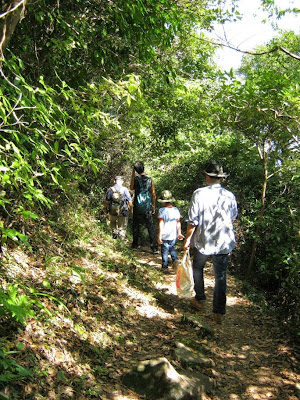Other days, being a missionary means dressing up like this:
 |
| "Santa-chan kawaii!" ("Miss Santa's so cute!") -the church ladies |
During the postlude of the very moving Christmas Eve service at Kuwamizu (in which I distributed candles and sang in the choir), I was quickly ushered into a Sunday School room and stuffed into that Santa dress, already wearing several layers underneath, to lead the people out to go caroling around the various baby, child, developmentally disabled, and elderly homes of the Colony of Love and Mercy. As I stood behind the doors to enter the sanctuary, a church lady went over my lines with me. After the service was over I was to rush into the sanctuary and in my loudest, cheerfulest voice, declare in Japanese, "Good evening everyone! Merry Christmas! Now we're going to go caroling! Please take one of these--" (hold up a candle) "--and gather at the athletic ground! Let's go!" After repeating the lines back to her three or four times--I kept forgetting to say the all-important "Merry Christmas"--she started to ring some sleigh bells and motioned for me to make my entrance.
I think the congregation was as shocked as I was. We stared at each other for a second before they started to ooh and applaud. I took a deep breath and said my lines in probably the loudest Japanese I've ever spoken. (Fear of making mistakes means I usually speak Japanese in a really quiet voice--my volume that night apparently really impressed Pastor Sumimoto.) And then I ran out the door and while waiting for everyone to gather bantered with some kids who recognized me from Sunday School. (It was mostly just them saying "Laura" and me saying "No, Santa" back and forth.)
We had just sung "Silent Night" at one of the homes when the church lady who'd helped me put the dress over my three layers took my arm and rushed me back to the Sunday School room. "Are you going to be on time to the English service?" she asked. "You should probably go change back into your regular clothes now."
"I'm okay, I'm okay," I said as I was escorted along. "I've got an hour still..." But still I found myself back in the Sunday School room with a bowl of hot pork soup and a steaming cup of green tea, which I gratefully devoured before hopping on my bike to Kumamoto Lutheran for the English Christmas Eve service.
Japan's general disregard for the true origins of Christmas bemused me last year and distressed me this year. I've talked before about how secular Christmas is here. It's more or less equivalent to Valentine's Day in the U.S. in level of importance, widespread unawareness of true origins, romantic associations, and confectionery sales. I said in my Christmas Eve entry this year that Luther is still open for extra classes and club activities on Christmas. And while J-3s didn't technically have to be at school on Christmas Day, we did have to opt out of something scheduled for that day. It left all the (all Christian) native English teachers a little taken aback, to be asked to attend something on Christmas at a Christian school.
The message at the International English Christmas Eve service that night was given by a former J-3 who still lives and teaches here in Kumamoto, and touched on that very point. We all know Christmas is more than Santa Claus and ho-ho-ho and mistletoe and presents to pretty girls. But... in truth, at its very heart, Christmas is not about generosity or spending time with loved ones either, as noble as those things are. The meaning of Christmas is God's greatest gift, a gift you don't get bored with one day later, a gift that plants itself in your heart and stays with you all year round. The meaning of Christmas, at its very core, is the coming of God's Son, the Messiah, Jesus Christ.
I'd had a potential blog entry swimming around my head about my frustrations with Japan's widespread ignorance of the sacredness of Christmas and how Santa and his reindeer fly up the side of the Tsuruya Department Store downtown, but if you want a Nativity set you have to bring it in from another country or make it yourself. But it's not my goal as a missionary to open a market for mass-produced manger scenes in Japan.
The message was a much-needed grounding for me. Jesus' love is so far beyond the confines of an annual 24-hour period, so much deeper than the relative mere warm fuzzies of familial love, so much more powerful and wild than a serene Nativity scene would suggest, so much more generous than anything you could put under a tree, so much more fulfilling than the best homemade Christmas feast. The Son of God! God-made-flesh! He came as a baby, born in one of the dirtiest, smelliest places on Earth because God wanted to reconcile us to Him that much. That's a big deal, yo! A bigger deal than having to report to school on December 25, that's for sure.
It's another bolster to my faith, one of the several I've accumulated since landing here almost 14 months ago. Praise be to God for His love and mercy that was born so long ago and is still with us today. Merry Christmas!
For to us a child is born,
to us a son is given,
and the government will be on his shoulders.
And he will be called
Wonderful Counselor, Mighty God,
Everlasting Father, Prince of Peace.
Isaiah 9:6 (NIV)










































